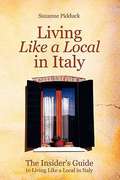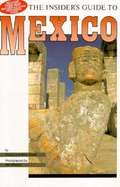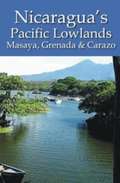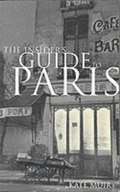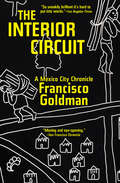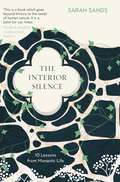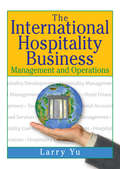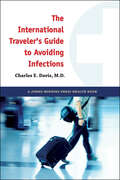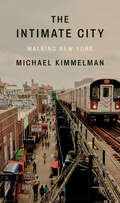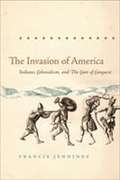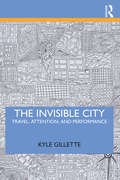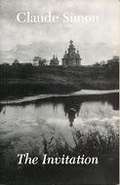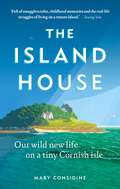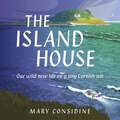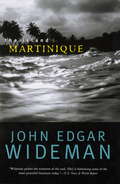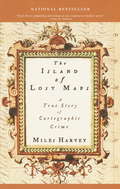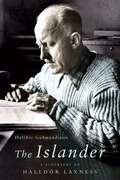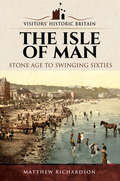- Table View
- List View
The Insider's Guide to Living like a Local in Italy
by Suzanne PidduckGetting ready to rent a villa or apartment in Italy? Find all you need to know about renting and traveling in Italy inside the pages of this book!
The Insider's Guide to Mexico
by Peggy Bond Mike BondA travel guide to Mexico that provides all information that visitors may need.
The Insider's Guide to Nepal
by Brian TetleyThe insider's guide book of Nepal provides travel information such as tourist attraction spots, restaurants, hotels, and much more.
The Insider's Guide to Paris
by Kate MuirLondon Times columnist Kate Muir has written this off-beat guide for those visitors to Paris who want to up-grade from tourist to native, if only for the weekend. Fresh, funny and full of information on where to go, what to see and what to buy.
The Insider’s Guide to New England
by Richard BondTravel guide on New England, provides all the information that travelers need.
The Insulin Express: One Backpack, Five Continents, and the Diabetes Diagnosis That Changed Everything
by Oren LiebermannA travel memoir through thirty countries, a thousand insulin injections, and one man’s journey from despair to confidence. With tips and information from the American Diabetes Association.In the middle of a yearlong backpacking trip around the world with his wife, Oren Liebermann is teaching English to young Buddhist monks in Pokhara, Nepal, when his body begins to fail him. He is constantly thirsty and exhausted, and by the time he steps on a scale, he has lost forty-five pounds. At a local clinic, a doctor gives him a diagnosis that will change his life forever: "I’m sorry to tell you, my friend, that you are a diabetic.”Devastated, Liebermann is trapped in a freezing hospital room, trying to recover enough to fly home. His friends and family urge him to call off the rest of his trip. He had quit his job as a TV news reporter for this dream-come-true journey, but the nightmare diagnosis has thrown his world into disarray. However, Liebermann and his wife, Cassie, make a decision. They have an adventure to finish, and he has the rest of his life to live.Bold, raw, and poignantly candid, The Insulin Express tells the story of what happens when the best-made travel plans are subject to the ever-present chaos of life, and how a major setback can turn into the opportunity of a lifetime. Despite struggling with a chronic disease that almost kills him in the Himalayas, Liebermann hikes along the Great Wall of China, conquers the Inca Trail to Machu Picchu, and sips cobra whiskey in Laos. What begins as a travel chronicle across thirty countries transforms into a single journey of resilience and self-discovery-going from hopelessly lost and then wonderfully found.
The Interior Circuit: A Mexico City Chronicle
by Francisco GoldmanThe author of Say Her Name shares a deeply personal memoir of grieving the loss of his wife—and confronting the troubled city where she grew up. Five years after his wife’s untimely death, Francisco Goldman decided to overcome his fear of driving in Mexico City. The widower and award-winning writer wanted to symbolize his love and enduring grief by fully embracing his late wife’s childhood home and the city that came to mean so much to them. The Interior Circuit is Goldman’s chronicle of his personal and political awakening to the nuances of this unique city as he learns to navigate the “circuito interior,” a network of highway-like roads that crisscross the traffic-plagued city. Many regard Mexico’s capital—then known as the “DF” or Distrito Federal—as a haven from the many social ills and violence that wracks the rest of the country. Goldman’s account reveals the more complicated truth. As Mexico’s narco war raged on and the Institutional Revolutionary Party (the PRI) returned to power in the summer 2012 elections, the DF’s special apartness came under threat. When organized crime–related violence and death erupt in the summer of 2013, Goldman sets out to try to understand the new challenges facing the city. Part travelogue, part memoir, and part political reportage, The Interior Circuit “is so sneakily brilliant it’s hard to put into words. . . . It is also, in the finest sense, a book that creates its own form” (Los Angeles Times).
The Interior Silence: 10 Lessons from Monastic Life
by Sarah Sands"Inspirational" - The Daily Mail"Sarah Sands has written about stillness with an eloquence that fizzes with vitality and wit. This wonderful book charts a journey to some of the most beautiful and tranquil places on earth, and introduces us to people whose inner peace is a balm for our troubled times. I loved every page of it." - Nicholas HytnerSuffering from information overload, unable to sleep, Sarah Sands, former editor of the BBC's Today programme, has tried many different strategies to de-stress... only to reject them because, as she says, all too often they threaten to become an exercise in self-absorption.Inspired by the ruins of an ancient Cistercian abbey at the bottom of her Norfolk garden, she begins to research the lives of the monks who once resided there, and realises how much we may have to learn from monasticism.Renouncing the world, monks and nuns have acquired a hidden knowledge of how to live: they labour, they learn and they acquire 'the interior silence'. This book is a quest for that hidden knowledge - a pilgrimage to ten monasteries round the world.From a Coptic desert community in Egypt to a retreat in the Japanese mountains, we follow Sands as she identifies the common characteristics of monastic life and the wisdoms to be learned from them; and as she discovers, behind the cloistered walls, a clarity of mind and an unexpected capacity for solitude which enable her, after years of insomnia, to experience that elusive, dreamless sleep.
The International Hospitality Business: Management and Operations
by Kaye Sung Chon Lawrence YuInternational Hospitality Business: Management and Operations will introduce hospitality managers to the most up-to-date developments in hospitality to prepare you for the rapidly changing world of international hospitality. This book is a compilation of the most current research in global operations. It examines new developments, new management co
The International Hotel Industry: Sustainable Management
by Timothy LockyerDevelop insight into the hotel management decision-making process.The International Hotel Industry: Sustainable Management examines key theoretical issues and real challenges facing current hotel managers around the world. Each chapter includes case studies of management issues, insights from senior international hotel managers, and stimulating dis
The International Living Guide to Retiring Overseas on a Budget: How to Live Well on $25,000 a Year
by Suzan Haskins Dan PrescherAchieve your dream of retiring abroad while on a budget The International Living Guide to Retiring Overseas on a Budget provides a detailed guide to one of the least-known but most effective retirement strategies in today's chaotic economic environment: retiring abroad. The premise is simple: Enjoy a happier, healthier, more fulfilling retirement than you could possibly afford in the U.S. or Canada by finding the right overseas retirement haven. The book reveals those affordable havens and the strategies for successfully making the move that could save your retirement. Aimed at retirees and near-retirees in the U.S. and Canada, this book's strategies apply just as well to younger people and people with families who are looking for ways to improve their quality of life while at the same time lowering their cost of living. It includes solutions for the challenges of continuing to work and earn money abroad, too. As long-time contributors to the acknowledged leader in the field, International Living, authors Suzan Haskins and Dan Prescher have at their disposal more than thirty years of International Living experience and expertise in the topic. They've been writing about living overseas for more than 12 years and have created their own broad and deep body of work, including regular blogs on the topic for Huffington Post and AARP. The authors include information and strategies that can be successfully applied by anyone regardless of their political or economic opinions. For anyone who wants a happier, healthier, more affordable life, The International Living Guide to Retiring Overseas on a Budget shows you how to enjoy the romance and excitement of living abroad on an affordable budget.
The International Traveler's Guide to Avoiding Infections (A Johns Hopkins Press Health Book #1)
by Charles E. DavisThe last thing a world traveler wants is to get sick. To stay healthy, travelers need to protect themselves from viruses, bacteria, and parasites, including many they have seldom, if ever, encountered. With precise, simple explanations, this indispensable guide helps international travelers avoid common—and uncommon—infections wherever they go. Relating important medical findings, Dr. Charles E. Davis provides the latest recommendations for healthy travel planning. He describes the precautions travelers can take to prevent infection, including• pre-trip travel clinic visits• essential immunizations and medications• travel insurance and medical kits• safe food and water practices• personal protection measures• post-trip checkupsThe International Traveler's Guide to Avoiding Infections is organized by disease, with highly accessible discussions and detailed illustrations of all the major travelers' infections. Maps make it easy to see where infections are commonly acquired, and specific prevention strategies for each destination enhance travel planning. Tourists and professionals such as military personnel, journalists, aid workers, and businesspeople need the tools provided here to stay healthy during their trip and after they return home.
The Intimate City: Walking New York
by Michael KimmelmanFrom the New York Times architecture critic, his celebrated walking tours of New York City, now expanded, covering four of the five boroughs and some 540 million years of history, accompanied by some of the people who know it bestAs New York came to a halt with COVID, Michael Kimmelman composed an email to a group of architects, historians, writers, and friends, inviting them to take a walk. Wherever they liked, he wrote—preferably someplace meaningful to them, someplace that illuminated the city and what they loved about it. At first, the goal was distraction. At a scary moment when everything seemed uncertain, walking around New York served as a reminder of all the ways the city was still a rock, joy, and inspiration. What began with a lighthearted trip to explore Broadway&’s shuttered theater district and a stroll along Museum Mile when the museums were closed soon took on a much larger meaning and ambition. These intimate, funny, richly detailed conversations between Kimmelman and his companions became anchors for millions of Times readers during the pandemic. The walks unpacked the essence of urban life and its social fabric—the history, plans, laws, feats of structural engineering, architectural highlights, and everyday realities that make up a place Kimmelman calls &“humanity&’s greatest achievement.&” Filled with stunning photographs documenting the city during the era of COVID, The Intimate City is the ultimate insider&’s guide. The book includes new walks through LGBTQ Greenwich Village, through Forest Hills, Queens, and Mott Haven, in the Bronx. All the walks can be walked, or just be read for pleasure, by know-it-all New Yorkers or anyone else. They take readers back to an age when Times Square was still a beaver pond and Yankee Stadium a salt marsh; across the Brooklyn Bridge, for green tea ice cream in Chinatown, for momos and samosas in Jackson Heights, to explore historic Black churches in Harlem and midcentury Mad Men skyscrapers on Park Avenue. A kaleidoscopic portrait of an enduring metropolis, The Intimate City reveals why New York, despite COVID and a long history of other calamities, continues to inspire and to mean so much to those who call it home and to countless others.
The Invasion Of America: Indians, Colonialism, and the Cant of Conquest
by Francis JenningsIn this iconoclastic book, Francis Jennings recasts the story of American colonization as a territorial invasion. The traditional history of early America paints the colonies as a transplantation of European culture to a new continent--a "virgin land" in which Native Americans were assigned the role of foil whose main contribution was to stimulate the energy and ingenuity of European dispossessors. Jennings rejects this ideology and examines the relationships between Europeans and Indians from a far more critical point of view. Shorn of old mythology and rationalizations, Puritan actions are seen in the cold light of material interest and naked expansion.
The Invisible City: Travel, Attention, and Performance
by Kyle GilletteThe Invisible City explores urban spaces from the perspective of a traveller, writer, and creator of theatre to illuminate how cities offer travellers and residents theatrical visions while also remaining mostly invisible, beyond the limits of attention. The book explores the city as both stage and content in three parts. Firstly, it follows in pattern Italo Calvino's novel Invisible Cities, wherein Marco Polo describes cities to the Mongol emperor Kublai Khan, to produce a constellation of vignettes recalling individual cities through travel writing and engagement with artworks. Secondly, Gillette traces the Teatro Potlach group and its ongoing immersive, site-specific performance project Invisible Cities, which has staged performances in dozens of cities across Europe and the Americas. The final part of the book offers useful exercises for artists and travellers interested in researching their own invisible cities. Written for practitioners, travellers, students, and thinkers interested in the city as site and source of performance, The Invisible City mixes travelogue with criticism and cleverly combines philosophical meditations with theatrical pedagogy.
The Invitation
by Claude Simon Jim CrossA fictionalized account of Simon's 1986 trip to Russia, where the people in the novel are discernible as his companions on the trip, offering their views of peace in the 21st century.
The Irish Bed and Breakfast Book 2008
by Elsie Dillard Susan CausinThis guide lists approximately 150 bed and breakfast locations in Ireland, organized by county. Each was visited by the authors, and are rated by friendliness, cleanliness, and value, and include price, contact information, a description, list of attractions in the area, and directions. Guesthouses, small hotels, inns, and restaurants with rooms are included.
The Island House: Our Wild New Life on a Tiny Cornish Isle
by Mary Considine'In the January dark, a young man walks slowly into the sea. He can't see where he is going, but he knows the island is calling...'Mary and Patrick's dream was to live in London, have 2.4 children, the nice house, the successful jobs. But life had other plans, and in one traumatic year that all came crashing down.Bruised and battered, Mary finds herself pulled towards Cornwall and dreams of St George's Island, where she spent halcyon childhood summers. So, when an opportunity arises to become tenants if they renovate the old Island House, they grab it with both hands.Life on the island is hard, especially in winter, the sea and weather, unforgiving. But the rugged natural beauty, the friendly ghosts of previous inhabitants, and the beautiful isolation of island life bring hope and purpose, as they discover a resilience they never knew they had.
The Island House: Our Wild New Life on a Tiny Cornish Isle
by Mary Considine'In the January dark, a young man walks slowly into the sea. He can't see where he is going, but he knows the island is calling...'Mary and Patrick's dream was to live in London, have 2.4 children, the nice house, the successful jobs. But life had other plans, and in one traumatic year that all came crashing down.Bruised and battered, Mary finds herself pulled towards Cornwall and dreams of St George's Island, where she spent halcyon childhood summers. So, when an opportunity arises to become tenants if they renovate the old Island House, they grab it with both hands.Life on the island is hard, especially in winter, the sea and weather, unforgiving. But the rugged natural beauty, the friendly ghosts of previous inhabitants, and the beautiful isolation of island life bring hope and purpose, as they discover a resilience they never knew they had.(p) 2022 Octopus Publishing Group
The Island Martinique
by John Edgar WidemanIn this compelling travel memoir, two-time PEN/Faulkner Award winner John Edgar Wideman explores Martinique's seductive natural beauty and culture, as well as its vexed history of colonial violence and racism. Attempting to decipher the strange, alluring mixture of African and European that is Creole, he and his French traveling companion develop a powerful attraction to one another which they find at once threatened and elevated by a third party - the island itself.
The Island of Lost Maps: A True Story of Cartographic Crime
by Miles HarveyThe Island of Lost Maps tells the story of a curious crime spree: the theft of scores of valuable centuries-old maps from some of the most prominent research libraries in the United States and Canada. The perpetrator was Gilbert Joseph Bland, Jr., an enigmatic antiques dealer from South Florida, whose cross-country slash-and-dash operation had gone virtually undetected until he was caught in 1995 and was unmasked as the most prolific American map thief in history. As Miles Harvey unravels the mystery of Bland's life, he maps out the world of cartography and cartographic crime, weaving together a fascinating story of exploration, craftsmanship, villainy, and the lure of the unknown.
The Island: Martinique
by John Edgar WidemanIn this compelling travel memoir, two-time PEN/Faulkner Award winner John Edgar Wideman explores Martinique's seductive natural beauty and culture, as well as its vexed history of colonial violence and racism. Attempting to decipher the strange, alluring mixture of African and European that is Creole, he and his French traveling companion develop a powerful attraction to one another which they find at once threatened and elevated by a third party—the island itself. A rich intersection of place, history, and the intricacies of human relations, Wideman's story gets deep into the Caribbean and close to the heart of the Creole experience.
The Islander: A Biography of Halldor Laxness
by Halldor Gudmundsson"An enthralling, heartening study of a man of unflagging interest in life" Independent"A thoroughly researched biography" New York Review of Books"Provides readers of English with a perfect introduction to the life and works of an outstanding writer, one whom everyone should read" Irish Times"I am thoroughly convinced by Gudmundsson's portrayal of Laxness" J. M COETZEEA strong and memorable portrayal of a man who fought heroically to write for the world, but in one of its rarest languages. Halldór Laxness won the Nobel Prize for literature in 1955. During his life, which spanned nearly the entire century, he not only wrote sixty books, but also became an active participant in Europe's idealistic debates and struggles.In the 1930s, Laxness became attracted to Soviet communism. He travelled widely in the Soviet Bloc and, despite witnessing some atrocities, remained a defender of communism until the 1960s. But his political leanings never dominated his work. Laxness continually sought to divulge the world of beauty that lurks beneath the everyday, ensuring his artistry remained a sanctuary of humanism and reflection.In this biography, Guðmundsson has been granted access to unique material by Laxness' family. As a result, the interrelationships between Laxness' personal life, his politics and his career are meticulously examined. What emerges is a grand description of a fascinating personality in which the manifold conflicts of the 20th century are mirrored."Laxness is a writer of the first degree, a writer I dreamed of coming close to" BORIS PASTERNAK, 1960"When in a bad mood I have picked one of your books. And there the pure and deep sound has welcomed me, strong and charming from the first page" KAREN BLIXEN in an open letter to Laxness in 1952Translated from Icelandic by Philip Roughton
The Islander: A Biography of Halldor Laxness
by Halldor Gudmundsson"An enthralling, heartening study of a man of unflagging interest in life" Independent"A thoroughly researched biography" New York Review of Books"Provides readers of English with a perfect introduction to the life and works of an outstanding writer, one whom everyone should read" Irish Times"I am thoroughly convinced by Gudmundsson's portrayal of Laxness" J. M COETZEEA strong and memorable portrayal of a man who fought heroically to write for the world, but in one of its rarest languages. Halldór Laxness won the Nobel Prize for literature in 1955. During his life, which spanned nearly the entire century, he not only wrote sixty books, but also became an active participant in Europe's idealistic debates and struggles.In the 1930s, Laxness became attracted to Soviet communism. He travelled widely in the Soviet Bloc and, despite witnessing some atrocities, remained a defender of communism until the 1960s. But his political leanings never dominated his work. Laxness continually sought to divulge the world of beauty that lurks beneath the everyday, ensuring his artistry remained a sanctuary of humanism and reflection.In this biography, Guðmundsson has been granted access to unique material by Laxness' family. As a result, the interrelationships between Laxness' personal life, his politics and his career are meticulously examined. What emerges is a grand description of a fascinating personality in which the manifold conflicts of the 20th century are mirrored."Laxness is a writer of the first degree, a writer I dreamed of coming close to" BORIS PASTERNAK, 1960"When in a bad mood I have picked one of your books. And there the pure and deep sound has welcomed me, strong and charming from the first page" KAREN BLIXEN in an open letter to Laxness in 1952Translated from Icelandic by Philip Roughton
The Isle of Man: Stone Age to Swinging Sixties (Visitors' Historic Britain)
by Matthew RichardsonDiscover the long and fascinating history of this tiny self-governing island in the Irish Sea. Many people don&’t know that the tiny Isle of Man, midway between the coasts of Lancashire and Northern Ireland, is one of the richest historic landscapes in Europe. Packed into its 225 square miles are dramatic stories of Bronze Age conflict, Viking warriors, medieval kings, smugglers, maritime and railway history, wartime airfields, and even a pirate radio station. Add to that the island's unique motorsport heritage (on two, three and four wheels), and you have a combination unrivaled anywhere in the British Isles. Whatever your passion, or whichever historical period appeals to you, the Isle of Man will have something fascinating to offer. Packed with illustrations, and using first-hand accounts to enhance the narrative, this book takes you on a chronological journey through the island&’s history, before offering a series of guided tours which pick up the highlights of each district. From Bronze Age hill forts to medieval castles, from heritage railways to historic quaysides, from award-winning museums to country mansions, the Isle of Man has it all. Let this book be your guide to historic Britain's best-kept secret, as you explore a place untouched by the hectic pace of twenty-first-century life. Includes photos
